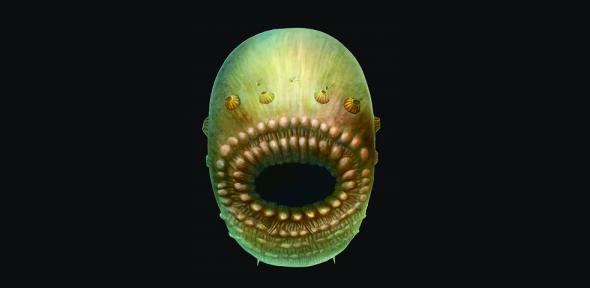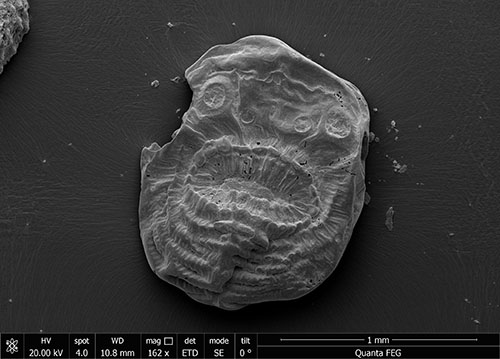
namely Saccorhytus, a newly discovered microfossil from the Lower Cambrian of Shaanxi province, China, making it 540 million years old. Here is a scanning electron micrograph of the actual fossil:

The Telegraph article quotes the senior author Simon Conway Morris as saying
“All deuterostomes had a common ancestor, and we think that is what we are looking at here.”But about the same time I was reading Acorn Worm Genome Shows Why Humans Can Swallow - With Gills In Between | Science 2.0, which tells us
Since acorn worms and the human lineage diverged 570 million years ago, pharyngeal slits for filtering food evolved into gills for extracting oxygen, and later into today's human upper and lower jaw and pharynx, which encompasses the thyroid gland, tongue, larynx (voice box) and various glands and muscles between the mouth and the throat. Humans and other terrestrial vertebrates actually initiate vestigial gills while embryos, though they disappear quickly and rarely persist in infants.Ouch! A time clash. The acorn worm estimate would be based on molecular biology. But if the Saccorhytus fossil is representative of the earliest ever deuterostome, how could it have travelled back 30 million years or more to be the ancestor of the acorn worms?
As always, get it from the horse’s mouth[1], or at least as near as one can get. A press release close to the source Bag-like sea creature was humans’ oldest known ancestor | University of Cambridge, however, tells us
Researchers have identified traces of what they believe is the earliest known prehistoric ancestor of humans – a microscopic, bag-like sea creature, which lived about 540 million years ago.
Named Saccorhytus, after the sack-like features created by its elliptical body and large mouth, the species is new to science and was identified from microfossils found in China. It is thought to be the most primitive example of a so-called “deuterostome” – a broad biological category that encompasses a number of sub-groups, including the vertebrates.
If the conclusions of the study, published in the journal Nature, are correct, then Saccorhytus was the common ancestor of a huge range of species, and the earliest step yet discovered on the evolutionary path that eventually led to humans, hundreds of millions of years later.
That may well be the source of the Telegraph quote, which would then have glossed over certain words of qualification. The study in question is Meiofaunal deuterostomes from the basal Cambrian of Shaanxi (China) and from the abstract we read
Depending on its exact phylogenetic position, the meiofaunal habit of Saccorhytus may help to explain the major gap between divergence times seen in the fossil record and estimates based on molecular clocks.Back to the Cambridge press release, we read
Modern humans are, however, unlikely to perceive much by way of a family resemblance. Saccorhytus was about a millimetre in size, and probably lived between grains of sand on the seabed. Its features were spectacularly preserved in the fossil record – and intriguingly, the researchers were unable to find any evidence that the animal had an anus.Which is a far more complicated issue than seems at first sight. A recent article (freely available) entitled Getting to the bottom of anal evolution deals with the gut morphology in the full range of Bilaterian animals, and contains the following observation:
In chordate deuterostomes, the blastopore-anus relationships is modified by the growth of the post-anal tail, and the blastopore closes in all cases and the anus forms elsewhere.Which includes ourselves, even though we don’t have much of a tail.
When I was much younger, and was reading books that had not caught up with the latest research, things seemed so simple. One could, so we were told, infer the history of a group of animals by looking at their embryonic or larval development, for example the presence of transient gill slits in a developing mammalian embryo could be referred back to a “fish stage” roughly 400 million years ago. But an interesting recent paper
Who came first--larvae or adults? origins of bilaterian metazoan larvae (you can download the PDF) sets the scene:
There is a classic controversy in zoology over whether the common ancestor of living bilaterian phyla was a benthic [bottom dwelling] animal with a bilaterian body plan, or was a pelagic [open water] larva-like animal similar to what we see today in the primary larvae of indirect-developing bilaterians. We examine the current larva-like adult hypothesis, and present an alternate model for the evolution of complex life histories by intercalation of larval features into the ontogeny of an ancestral direct-developing bilaterian.The larvae here are not those of insects or amphibians, which already contain many features of the adult body plan. In dealing with starfish, marine worms, and molluscs, where the larva to adult metamorphosis involves an much more drastic change of body plan, the authors present an alternative to the traditional view, in which the free-floating larvae are a later (shortly before or during the Cambrian!!!) development which allows the production of large numbers of free-swimming larvae which are able to move around to escape predators, find food, and to be dispersed to far regions by currents, thereby getting an edge on their competitors. (For a while, at least, then along came creatures with strategies to catch larvae like these.)
[1] This expression may derive from horse racing as in ‘Straight from the horse’s mouth’; – the meaning and origin of this phrase or from an Ancient Greek account of philosophers trying to work out how many teeth a horse has.



Comments